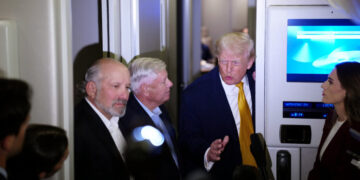Con contractor couple left over 40 Texas clients with unfinished, unsafe homes in nearly $5M fraud scheme
A young Texas couple posing as contractors conned dozens of clients out of $4.8 million in a scheme that left...
Denmark urges Trump to stop threatening to annex Greenland
Danish Prime Minister Mette Frederiksen said Trump has no right to annex Greenland. Associated Press, Alex Wong/Getty ImagesThe leaders of...
NFL playoff picture: Breaking down each wild-card matchup
1 p]:text-cms-story-body-color-text clearfix”> DENVER — Third time’s the charm? Twice in club history, the Chargers lost playoff games at New...
Sara Foster praises Trump’s capture of Maduro, says Venezuela is ‘liberated today, truly’
Sara Foster celebrated Saturday the U.S. capture of Venezuelan leader Nicolás Maduro. In a series of social media posts, the daughter...
Luka Doncic has 36 points as Lakers defeat the Grizzlies
They met two days prior to Sunday night’s encounter at Crypto.com Arena, a two-game set between the Lakers and Memphis...
Francis Patrelle, Champion of the Story Ballet, Dies at 78
Francis Patrelle, a ballet teacher and choreographer who built a tightly knit community in New York around his classes at...
Elon Musk dined with Donald Trump during a very busy weekend for the president
Elon Musk had dinner with Donald Trump during a busy weekend for the president. Tom Brenner For The Washington Post...
Shamans’ Eerie 2026 Predictions Are Already Coming True
Just days into the new year, Peruvian shamans have already seen one of their annual predictions materialize. A group of...
‘Peace President’ Trump Threatens Attack on Another Country
Self-proclaimed “peace president” Donald Trump is openly flirting with military action against yet another nation. After striking Venezuela’s capital and...
Venezuela’s New Leader Calls for Dialogue and ‘Coexistence’ With U.S.
A day after a blistering speech in which she accused the Trump administration of illegally kidnapping Nicolás Maduro, Venezuela’s head...














